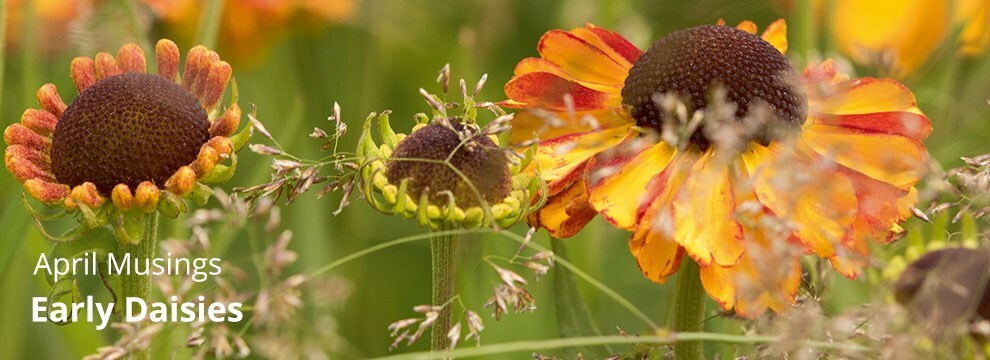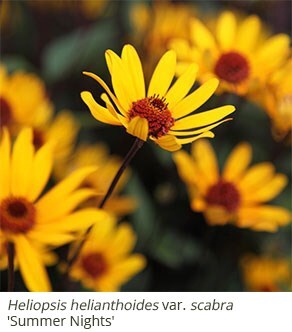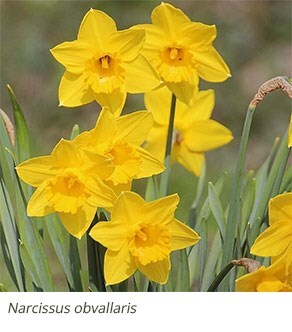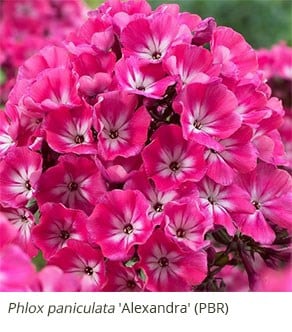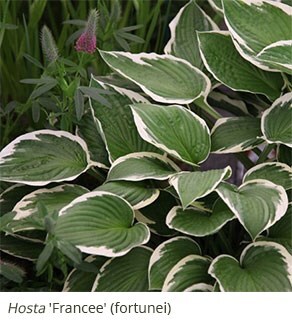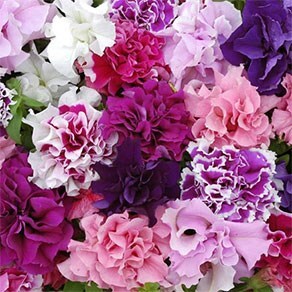|
April’s one of the best planting months of all when it comes to perennial plants, because many planted now will flower during summer and autumn this year. The soil is warm and there should be some April showers to water them in as the days get longer. One of the most useful is the daisy, because there are hundreds of tiny flowers packed into a pincushion centre. Each individual flower is very attractive to bees of all types because there’s a nectary at the base of every one. The open flowers are also very accessible to honeybees, bumblebees and solitary bees alike.
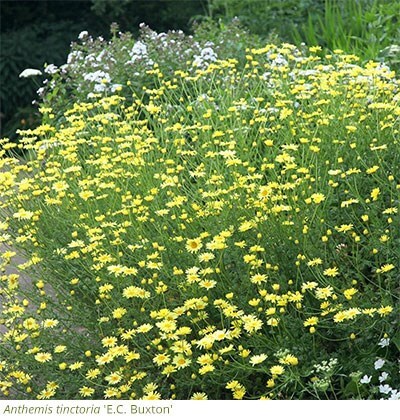 The showy part of the plant, the ray petals around the edge, flag up the flower’s presence to pollinators, but they also use another device. The petals near the middle often contain nanostructures, or ridges and bumps. These cause light to be reflected in a different way to a rainbow. Instead the bumps reflect blue and ultraviolet light so the bees pick up a halo of blue surrounding the middle. Blue is the favourite colour of many bees, so they're drawn to these plants like iron filings to a magnet. The showy part of the plant, the ray petals around the edge, flag up the flower’s presence to pollinators, but they also use another device. The petals near the middle often contain nanostructures, or ridges and bumps. These cause light to be reflected in a different way to a rainbow. Instead the bumps reflect blue and ultraviolet light so the bees pick up a halo of blue surrounding the middle. Blue is the favourite colour of many bees, so they're drawn to these plants like iron filings to a magnet.
It’s important to understand that the word daisy is a corruption of ‘day’s eye’, indicating their need for sunshine and an open position in order to flower well. Daisies are not plants for shady spots, so there are very few spring-flowering daisies.
One of the earliest daisies to flower after spring is Anthemis, sometimes called dyer’s chamomile because the yellow flowers can be used to dye sheep’s wool. Their foliage is highly divided and slightly aromatic and both indicate a preference for sun and good drainage. Aromatic foliage is covered in pungent oil that acts as a sunscreen to plants. Anything pungent wants to bask in the sun!
Anthemis tinctoria ‘Sauce Hollandaise’ can produce flowers in May and it’s sterile, so there are no seedlings. Consequently it flowers for many months, producing smaller daisies in creamy yellow and it can still be flowering in autumn. The flowers are very dainty affairs, small spinning saucers on wiry stems, and they mix well with blue catmints such as Nepeta racemosa ‘Walker’s Low’ or ‘Junior Walker’.
Later in the year, a larger flowered and brasher yellow anthemis called ‘E.C. Buxton’ appears in the garden. This has thicker, woodier stems and greener foliage. The flowers are luminous, even in bright sunlight, and this Welsh bred plant, with filigree green foliage, will tolerate more moisture. It has a stately presence other anthemis lack.
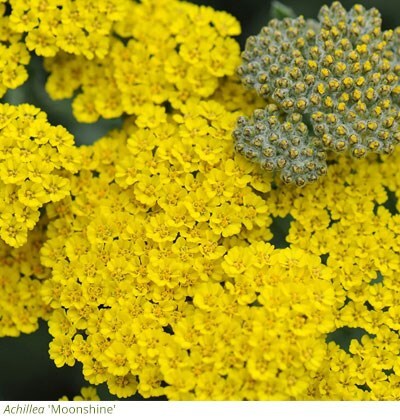 Anthemis does tend to lose vigour after a while, so it pays to pull some of the outer pieces away at the base every summer. These pieces will generally have a piece of root and, in horticulture, they’re called Irishman’s cuttings. These will root within 4 to 6 weeks. You can also do the same with achilleas and these are also members of the daisy family, despite their domed appearance. The tiny flowers are miniature daisies packed into a cauliflower like head. They each contain a middle and outer florets and their flat heads add a different dimension to the structure of a sunny border. Very few plants have this sturdy flat-topped profile as they fade into winter. Anthemis does tend to lose vigour after a while, so it pays to pull some of the outer pieces away at the base every summer. These pieces will generally have a piece of root and, in horticulture, they’re called Irishman’s cuttings. These will root within 4 to 6 weeks. You can also do the same with achilleas and these are also members of the daisy family, despite their domed appearance. The tiny flowers are miniature daisies packed into a cauliflower like head. They each contain a middle and outer florets and their flat heads add a different dimension to the structure of a sunny border. Very few plants have this sturdy flat-topped profile as they fade into winter.
They share the same sort of aromatic foliage and this is often highly divided. Those with silver foliage need drier conditions. If the foliage is greener, they cope with more moisture. These sun lovers take their name from the Greek hero Achilles who led his soldiers, the Myrmidons, into battle. This magical plant was picked to protect each of Achilles’ soldiers from being wounded. It was also used to cleanse any wounds and one common name was Staunch grass. The practice of packing wounds went on right up until the American Civil War in the mid 19th century.
There are lots of garden achilleas but perhaps the finest of all is ‘Moonshine’, a plant raised by Norfolk plantsman Alan Bloom in 1954. He considered it one of his best, because the acid yellow flowers and grey filigree foliage begin to make an impact in May and then carry on until October. Its tendency to get woody after three years or so means it has to be propagated. This is easy, just pull some of the new growth away at the base and pot it up in gritty compost.
There is a far taller bright yellow called ‘ Cloth of Gold’ that reaches over a metre high, or up to 4 feet. This also needs a sunny spot but you can use it among later flowering perennials because it will still be showing touches of yellow when plants like eupatorium flower. It can also be used among taller grasses.
The German plantsman Ernst Pagels pioneered late season grasses, especially miscanthus. He bred companion perennials that faded into winter and selected plants with strong stems and good winter seed heads to compliment his beloved grasses. Pagel’s ‘Terracotta’ has biscuit-orange heads that fade to cream in time, so it looks wonderful with bleached summer grasses such as ponytail grass (Stipa tenuissima). ‘Walther Funcke' is a deeper colour and flowers earlier, often by June. Pagels raised both in his 90's, in the early years of the 21st century.
 Not all achilleas are yellow or orange though. ‘Red Velvet’ does what it says on the tin and produces red flowers studded with tiny orange centres. ‘Summerwine’ has two tone pink and cerise flowers that blend with summer flowering herbaceous. Achilleas must have good drainage to stand up well, otherwise they can be floppy. They will also flop if they’re overfed. Grow them well, but hard, and they will make good cut flowers - if you can bear to cut them! Not all achilleas are yellow or orange though. ‘Red Velvet’ does what it says on the tin and produces red flowers studded with tiny orange centres. ‘Summerwine’ has two tone pink and cerise flowers that blend with summer flowering herbaceous. Achilleas must have good drainage to stand up well, otherwise they can be floppy. They will also flop if they’re overfed. Grow them well, but hard, and they will make good cut flowers - if you can bear to cut them!
Heleniums will also flower in the middle of summer and the earliest of all is another sterile hybrid that flowers and then reblooms - ‘Sahin’s Early Flowerer’. This one was selected from a field containing thousands of seedlings roughly 20 years ago. It stood out because it out-flowered everything else in the field. The flowers must have a jumping gene, because they are a mixture of dazzling oranges and all slightly different. As a result this excellent plant seems to shimmer in the border. This helenium, one of the best plants to emerge in the last 20 years or so, is also far more tolerant of drier conditions. If you’ve failed to grow heleniums in the past, do have a go with this bobby dazzler. The double skirted mahogany-red ‘Moerheim Beauty’ needs good soil, but it’s still a showstopper despite coming up to its hundredth birthday. The double layer of petals flounces outwards like a skirt on a dancer.
Heleniums are North American plants and many of the fleabanes, (or erigerons), also come from North America as well. Erigeron glaucous ‘Sea Breeze’ is native to the coastline of Oregon and California so its common name is sea daisy. It's the low growing, golden centred, lilac-pink daisy that is often mistaken for an aster. It's commonly grown on the wall or a rockery, but equally good in a pot, and it flowers in spring, producing thickly petalled flowers.
The Mexican fleabane, Erigeron karvinskianus, is far daintier in form, with tiny pink daisies that age to white. This is excellent at the front of a border and it’s very adept at self seeding in crevices and cracks either on paving, or on steps. It’s popular with bees and, in very hot weather, the flowers can darken to campion pink. I couldn’t do without it!
 Echinaceas join the party by July and the easiest to grow are seed raised strains of Echinacea purpurea. ‘Magnus’ has large pink flowers and ‘White Swan’ has a ray of white petals set round a golden disc. These will both endure through winter in the ground. There are now double forms and they include ‘Pink Double Delight’. ‘Coconut Lime’, another double, has cream flowers suffused in green. Doubles can rot in wet weather, so carefully deadhead any spent blooms in wet summers. The shorter ‘Amazing Dream’ has single hot pink petals and an orange tinted cone. Echinaceas join the party by July and the easiest to grow are seed raised strains of Echinacea purpurea. ‘Magnus’ has large pink flowers and ‘White Swan’ has a ray of white petals set round a golden disc. These will both endure through winter in the ground. There are now double forms and they include ‘Pink Double Delight’. ‘Coconut Lime’, another double, has cream flowers suffused in green. Doubles can rot in wet weather, so carefully deadhead any spent blooms in wet summers. The shorter ‘Amazing Dream’ has single hot pink petals and an orange tinted cone.
There are lots of reds, peaches and oranges now, but these don’t always endure through winter. The Americans use them widely as ‘pots of summer colour’ so fancier echinaceas are often best grown in pots placed in strategic places, as you would agapanthus.
Enjoy them in summer and keep the winter wet out by laying the pot on their sides, or place them in an unheated greenhouse during the wet, winter months. Growing them in pots will allow you to examine the intricacies of fancier echinaceas such as the pale green ‘Green Jewel’ and ‘Green Envy’, a plant with pink petals that fade to green.
Echinaceas are highly attractive to bumblebees and they make a real statement of the border because the dark stems support horizontal flowers with huge middles. The buds are also sensational. Team them with Hylotelephium telephium ‘Purple Emperor’ for extra smoulder and eye appeal. |



